16 Effective Ayurvedic Face Packs For Glowing Skin
Get ready to be complimented because these remedies shall revitalize your face.
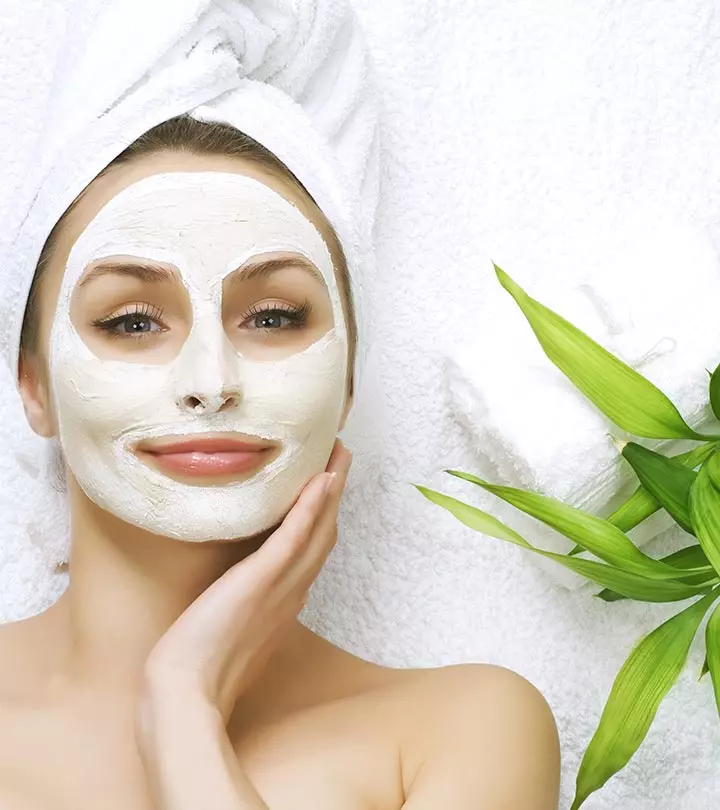
Image: Shutterstock
Nature is the best medicine, and you know how beneficial natural products are for your skin. Ayurveda, the ancient and holistic science, can be the answer to almost all your skin care troubles. Ayurvedic face packs for glowing skin are one of the best ways to help your skin heal and glow brightly.
If you are looking for chemical-free products for balanced skincare, these face packs are the best bet. They are the best-kept secrets of nature that help improve your skin health. Keep reading to know a few easy face pack recipes you can prepare at home. Scroll down for the best natural remedies for healthy skin.
In This Article
Best Ayurvedic Face Packs For Glowing Skin
Note:
Although these recipes involve natural ingredients, it doesn’t make them entirely safe for you. You can be allergic to any ingredient. Hence, do a patch test before trying these beauty solutions.
1. Turmeric And Besan Face Pack

Turmeric is a natural antiseptic and has anti-inflammatory and antibacterial properties (1). It is also known for its skin brightening effects. Besan is a good exfolianti A chemical substance that is applied to the surface of the skin to remove any dirt or dead skin cells. and helps in maintaining the pH balance of your skin. Here is how you can prepare this face pack for glowing skin:
You Will Need
- 1 tablespoon besan (gram flour)
- ½ tablespoon turmeric
- 1 tablespoon rose water
What You Have To Do
- Mix all the ingredients and make a thick paste.
- Apply it to your face and neck.
- Leave it on for 15 minutes and then wash off.
How Often You Should Do This
Two times a week.
Elizabeth Pagany, a blogger, tried a turmeric and gram flour (besan) face pack and shared how it improved her skin. She writes, “This particular face mask helps with any acne scarring, dullness, blemishes, hyperpigmentation, and reveals your skin’s natural glow. All the ingredients in this mask work together to brighten the skin’s complexion and to prevent acne. This is my go to skincare regimen for a quick and easy glow up (i).”
2. Marigold Flower Face Pack
Marigold is widely used in Ayurvedic face packs for its healing effect. A study done on human fibroblast cells (cells that produce collageni A protein found in the skin’s connective tissue that helps strengthen the bones and gives structure to skin. ) found that due to the high levels of polyphenolsi Compounds with anti-inflammatory and antioxidant qualities that may help reduce the risk of many ailments, including cancer or diabetes. , marigold extracts can prevent photoagingi Skin damage that happens due to excess exposure to the sun's UV rays, the risk of which could be higher with an absence of sunscreen. and degradation of the fibroblast cells, thereby maintaining healthy skin (2).
You Will Need
- 2 marigold flowers (crushed)
- ½ tablespoon yogurt
What You Have To Do
- Crush the marigold petals and add curd to make a paste.
- Apply the paste to your face and neck and leave it on for 20 minutes.
- Rinse with water.
How Often You Should Do This
Three times a week.
3. Sandalwood Face Pack
Sandalwood oil
has anti-inflammatory and antibacterial properties and may potentially help in inhibiting pigmentation related to aging and UV exposure and the growth of S.aureus (bacteria that cause acne and pimples) (3). Sandalwood face pack has many skin benefits. Check out how to prepare this best face pack for glowing skin below:
You Will Need
- 2-3 drops of sandalwood oil
- 1 teaspoon of carrier oil (jojoba or sweet almond oil)
- 1 teaspoon of honey
What You Have To Do
- Mix two to three drops of sandalwood oil with a teaspoon of the carrier oil.
- You can add a teaspoon of honey to this mixture for additional skin nourishment.
- Blend well and apply the face pack.
- Allow it to sit for 15-20 minutes and then wash it off.
How Often You Should Do This
Two to three times a week.
Note: Before using any essential oil, a patch test is mandatory.
 Quick Tip
Quick Tip4. Honey And Lemon Face Pack

If you want to know how to get glowing skin naturally, we will tell you what you need. Start with honey. It contains vitamins, minerals, amino acids, antioxidants (flavonoids), and certain enzymesi The proteins that help accelerate the process of certain chemical reactions in the body. that make it a good anti-inflammatory, antimicrobial, healing, and cleansing agent. These properties of honey help to keep your skin healthy and prevent acne (4). Lemon contains vitamin C and citric acid. Many skincare enthusiasts swear by the brightening and astringent effect of lemon.
You Will Need
- 1 teaspoon organic honey
- A few drops of lemon juice
What You Have To Do
- Mix 3-4 drops of lemon juice in a teaspoon of honey.
- Apply all over your face. Avoid the area around your eyes.
- Wash it off after 20 minutes.
How Often You Should Do This
Two to three times a week.
Note: Lemon juice makes your skin photosensitive. Hence, make sure you apply sunscreen before stepping out.
5. Lavender Oil Face Pack
The topical application of lavender oil promoted collagen synthesis and wound healing in a rat study
(5). Hence, applying lavender oil may help make your skin plump and healthy (by boosting collagen production).
You Will Need
- 3-4 drops lavender essential oil
- 1 teaspoon avocado or jojoba oil
What You Have To Do
- Dilute two to three drops of lavender oil in a teaspoon of avocado or jojoba oil.
- Massage the blend on your face and leave it on for 20-30 minutes.
- Wash your face with lukewarm water.
How Often You Should Do This
Three times a week.
Note: Do a patch test before using lavender essential oil. Also, store it in an airtight bottle, away from sunlight, as oxidized essential oils may cause skin irritation.
6. Neem, Tulsi, And Turmeric Face Pack
Applying neem oil may reduce signs of skin aging. Neem face packs are very effective for all skin types. According to a study, topical application of neem oil on mice skin improved type 1 procollageni The precursor to collagen that acts as a source of protein to support the body tissues and also serves as an indicator of bone formation. and elastini A protein found in all connective tissues that adds stretchability to the skin, allowing it to stretch and shrink back again. production and helped in reducing skin aging (6). Tulsi has antibacterial and anti-inflammatory effects that aid skin healing and keep it healthy (7). You can add turmeric to these nutritious herbs to get a nourishing face mask.
You Will Need
- 4 tulsi leaves
- 3-4 neem leaves
- 1 teaspoon turmeric
- 1 teaspoon yogurt
What You Have To Do
- Make a paste of the tulsi and neem leaves.
- Add a pinch of turmeric and a teaspoon of yogurt to the paste and mix well.
- Spread the mask on your face. Let it dry.
- Wash it off.
How Often You Should Do This
Every alternate day.
7. Rice Flour And Sandalwood Face Pack
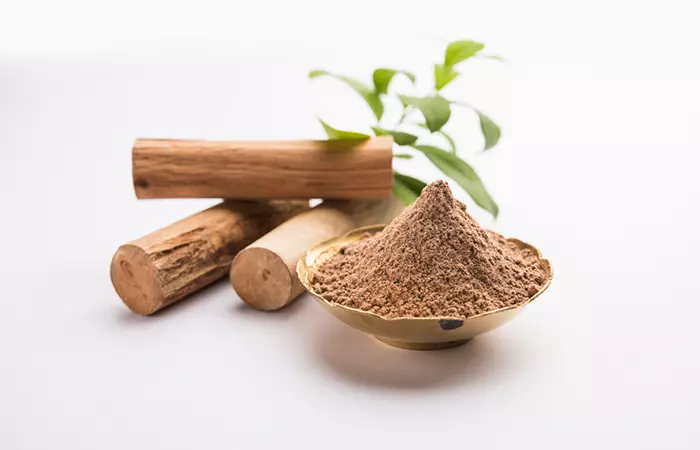
Coarse rice flour can be a great substitute for store-bought scrubs. This homemade face pack for glowing skin will help remove dead skin cells from your skin and brighten it.
You Will Need
- 1 tablespoon rice flour
- 2-3 drops of sandalwood oil or ½ teaspoon sandalwood powder
- 1 tablespoon rose water
What You Have To Do
- Combine all ingredients in a bowl and make a paste.
- Apply the paste to your face and massage for 5 minutes.
- Let it dry for 5-10 minutes.
- Wash it off.
- Follow up with a moisturizer.
How Often You Should Do This
Once a week.
8. Oatmeal, Turmeric, And Sandalwood Face Pack
Colloidal oatmeal (boiled oats) can cleanse your skin thoroughly. It contains saponins that can effectively remove all impurities from the skin. It also reduces skin inflammation (8). Along with turmeric and sandalwood, it makes for an excellent face pack to keep your skin healthy.
You Will Need
- 1 tablespoon boiled oats
- 2-3 drops of sandalwood oil or ½ teaspoon sandalwood powder
- A pinch of turmeric
- Rosewater
What You Have To Do
- Combine all ingredients in a bowl and make a paste.
- Apply the paste to your face and massage it on your skin for 5 minutes. Let it dry.
- Wash it off.
How Often You Should Do This
Two to three times a week.
 Quick Tip
Quick Tip9. Turmeric, Besan, And Milk Face Pack
This herbal face pack can fade blemishes by exfoliating your skin and removing dead skin cells. Besan and turmeric work together to reduce tanning and make your skin bright, while the lactic acid in milk keeps it soft.
You Will Need
- 1 tablespoon besan (gram flour)
- 2 tablespoons milk
- ½ teaspoon turmeric powder
What You Have To Do
- Combine the ingredients in a bowl.
- Apply the paste evenly all over your face.
- Massage gently and let it dry.
- Wash it off.
How Often You Should Do This
Once a week.
10. Aloe Vera, Lemon, And Honey Face Pack

Aloe vera face pack can help prevent acne. It promotes collagen and elastin production by stimulating the fibroblastsi A common cell type found in connective tissues that are responsible for the production of collagen. in your skin. This improves skin quality and health (9). Together with lemon and honey, it can brighten the skin and keep it soft.
You Will Need
- 2 tablespoons aloe vera gel
- ½ teaspoon lemon juice
- 1 teaspoon honey
What You Have To Do
- Mix the aloe vera gel, lemon juice, and honey in the specified quantities.
- Apply the pack to your face. Avoid the eye area.
How Often You Should Do This
Two times a week.
11. Tomato And Multani Mitti Face Pack
Tomato contains lycopene that can protect your skin from UV ray damage (10). Multani mitti or Fuller’s earth has skin-cleansing properties. It removes dirt and impurities to keep the skin bright.
You Will Need
- 1 tablespoon Multani mitti
- 2 tablespoons tomato juice
What You Have To Do
- Mix the Multani mitti and tomato juice in a bowl until you get a fine paste.
- Apply the face pack and let it dry.
- Wash it with water.
How Often You Should Do This
Two to three times a week.
12. Amla (Gooseberry) Face Pack
A study found that amla or gooseberry might promote procollagen production and improve skin health. Amla was found to have skin tightening and firming properties (11). It suggested that amla extracts could have therapeutic and cosmetic applications.
You Will Need
- 1 teaspoon gooseberry paste (amla)
- 1 tablespoon curd
What You Have To Do
- Mix the amla paste with curd in a bowl.
- Apply the paste to your face. Let it dry.
- Wash with water.
How Often You Should Do This
Two to three times a week.
13. Yogurt And Turmeric Face Pack

If you are looking for a daily face pack for glowing skin, try this turmeric and yogurt face pack. It helps to calm your skin, brighten it, and keep your skin healthy and supple.
You Will Need
- 2 tablespoons yogurt
- ½ teaspoon turmeric
What You Have To Do
- Mix two tablespoons of yogurt with half a teaspoon of turmeric powder.
- Apply the paste to your face. Let it dry.
- Wash with water.
How Often You Should Do This
Two to three times a week.
14. Mulethi (Licorice) And Milk Face Pack
Healing herbs like licorice can reduce sun-induced pigmentation. It contains glabridin, which has anti-inflammatory properties that help reduce pigmentation (12).
You Will Need
- 1 teaspoon licorice powder
- 2 teaspoons milk
What You Have To Do
- Mix a teaspoon of licorice powder with two teaspoons of milk.
- Apply the paste to your face.
- Wash with water once the pack dries.
How Often You Should Do This
Two to three times a week.
Maintaining a healthy diet and sustainable mind-body beauty practices along with using these face packs is key to healthy and glowing skin.
15. Fuller’s Earth And Honey Face Pack
Fuller’s earth or Multani mitti helps to cleanse your skin. It absorbs oil and dirt, removes dead skin cells, and brightens the face. Along with honey, it keeps your face clean, soft, and bright.
You Will Need
- 1 tablespoon Fuller’s earth
- 1 tablespoon honey
- Rosewater
What You Have To Do
- Mix a tablespoon each of Multani mitti and honey.
- Add rose water and mix well until you get a paste-like consistency.
- Spread the pack on your face evenly and let it dry.
- Wash it off with water.
How Often You Should Do This
Two times a week.
16. Banana And Honey Face Mask

The banana and honey face mask is a nourishing and moisturizing homemade remedy for beautiful skin. Bananas are rich in water and vitamins B12 and C, which help moisturize the skin and improve skin elasticity (13). Honey helps hydrate the skin moisture, while its antimicrobial properties may inhibit the growth of acne-producing bacteria, helping combat acne (4), (14). You can use this face mask for glowing skin.
You Will Need
- 1 ripe banana
- 1 tablespoon of honey
What You Have To Do
- Mash a ripe banana and mix in the honey to create a well-blended mixture.
- Apply the mask evenly to a cleansed face. Avoid the eye area.
- Leave it on for about 15-20 minutes to allow the nutrients to penetrate your skin.
- Rinse it off with lukewarm water.
- Pat your skin dry and follow up with a moisturizer.
How Often You Should Do This
Two times a week.
You can readily prepare these face packs for glowing skin at home, and enjoy their wondrous benefits.
Infographic: Top DIY Ayurvedic Face Packs For Glowing & Healthy Skin
It’s time to stop using the cosmetic treatments, creams, and lotions that have taken over your skincare routine. Change to the conventional, 5,000-year-old way of life known as Ayurveda if you want to care for your skin over the long term. It entails applying safe, mild, and effective natural ingredients to your skin.
Check out the infographic below to learn how to prepare the best self-care face packs at home for beautiful, healthy skin. Illustration: StyleCraze Design Team

Ayurvedic face packs are natural and cost-effective ways to keep your skin radiant and healthy. Natural ingredients such as turmeric, sandalwood, lavender, honey, and lemon have antimicrobial and anti-inflammatory properties that exfoliate the skin, reduce pigmentation and acne, hydrate the skin, and improve the overall texture and health of the skin. While these are natural ingredients and are safe to use, perform a patch test before adding any ingredient to your beauty regimen. It will ensure you are not allergic to any ingredient. If you experience any allergic reaction to an ingredient, consult your doctor immediately.
Frequently Asked Questions
Can we use an Ayurvedic face pack daily?
Yes, you can use an Ayurvedic face pack daily for natural radiance. It is safe and has fewer to no side effects.
Can you apply sandalwood oil directly to the skin?
No, since sandalwood oil is an essential oil, always dilute the oil with a carrier oil before applying it to the skin.
Can we store the Ayurvedic face pack in the fridge?
Yes, you can store the Ayurvedic face pack in the fridge. It may last for one or two weeks. However, it is best to use it within a week.
What are the side effects of Ayurvedic face packs?
Ayurvedic skin care products and face packs are generally safe to use on the skin. However, some people may have allergic reactions to the ingredients since they are made with home-based ingredients. So, it is always best to do a patch test before applying to know how they react to your skin.
Key Takeaways
- Neem, sandalwood, and turmeric face packs can help enhance the health and appearance of your skin.
- Ayurvedic face packs can support pH balance and encourage a glowing, radiant complexion.
- Acne, age spots, and wrinkles can all be prevented and treated with the regular use of Ayurvedic face packs.
- Always pick ingredients that suit your skin type, like besan for oily skin and honey and milk for dry to normal skin.
- Incorporate herbal treatments and oils in your ayurvedic skincare regimens to nourish and protect your skin.
Illustration: Effective Ayurvedic Face Packs For Glowing Skin
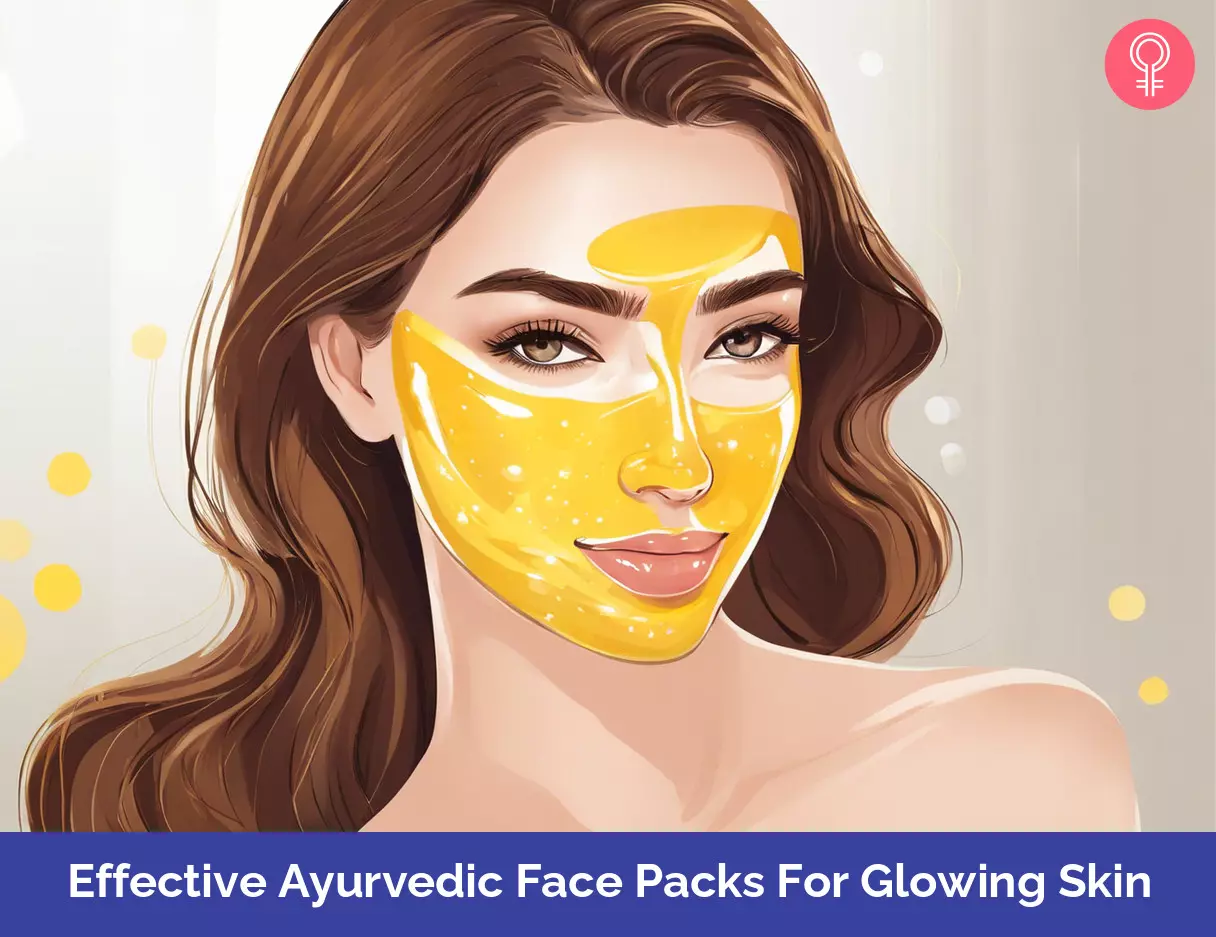
Image: Stable Diffusion/StyleCraze Design Team
Uncover the top incredible ways to utilize honey for clear, healthy, and radiant skin. Enhance your beauty regimen with natural face masks, scrubs, and more, all crafted with the help of honey. Click play on this captivating video for natural glowing skin.
Personal Experience: Source
StyleCraze's articles are interwoven with authentic personal narratives that provide depth and resonance to our content. Below are the sources of the personal accounts referenced in this article.
i. Turmeric Skin Brightening Face Mask DIY;https://paganyelizabeth.medium.com/turmeric-skin-brightening-face-mask-diy-de901751cf0f
References
Articles on StyleCraze are backed by verified information from peer-reviewed and academic research papers, reputed organizations, research institutions, and medical associations to ensure accuracy and relevance. Read our editorial policy to learn more.
- Effects of Turmeric (Curcuma longa) on Skin Health: A Systematic Review of the Clinical Evidence. Phytotherapy Research, US National Library of Medicine, National Institutes of Health.
https://pubmed.ncbi.nlm.nih.gov/27213821/ - Antioxidant and Skin Anti-Aging Effects of Marigold Methanol Extract, Toxicological Research, US National Library of Medicine, National Institutes of Health.
https://www.ncbi.nlm.nih.gov/pmc/articles/PMC5776915/ - Sandalwood Album Oil as a Botanical Therapeutic in Dermatology, The Journal of Clinical and Aesthetic Dermatology, US National Library of Medicine, National Institutes of Health.
https://www.ncbi.nlm.nih.gov/pmc/articles/PMC5749697/ - Medicinal and cosmetic uses of Bee’s Honey – A review, Ayu, US National Library of Medicine, National Institutes of Health.
https://www.ncbi.nlm.nih.gov/pmc/articles/PMC3611628/ - Wound healing potential of lavender oil by acceleration of granulation and wound contraction through induction of TGF-β in a rat model, BMC Complementary and Alternative Medicine, US National Library of Medicine, National Institutes of Health.
https://www.ncbi.nlm.nih.gov/pmc/articles/PMC4880962/ - Topical application of neem leaves prevents wrinkles formation in UVB-exposed hairless mice, Journal of Photochemistry and Photobiology, ScienceDirect.
https://www.sciencedirect.com/science/article/abs/pii/S1011134416303323 - Tulsi – Ocimum sanctum: A herb for all reasons, Journal of Ayurveda and Integrative Medicine, US National Library of Medicine, National Institutes of Health.
https://www.ncbi.nlm.nih.gov/pmc/articles/PMC4296439/ - Colloidal oatmeal: history, chemistry and clinical properties. Journal of Drugs in Dermatology, US National Library of Medicine, National Institutes of Health.
https://pubmed.ncbi.nlm.nih.gov/17373175/ - Aloe Vera: A Short Review, Indian Journal of Dermatology, US National Library of Medicine, National Institutes of Health.
https://www.ncbi.nlm.nih.gov/pmc/articles/PMC2763764/ - Tomato paste rich in lycopene protects against cutaneous photodamage in humans in vivo: a randomized controlled trial. The British Journal of Dermatology, US National Library of Medicine, National Institutes of Health.
https://pubmed.ncbi.nlm.nih.gov/20854436/ - Skin Ageing: Natural Weapons and Strategies, Evidence-Based Complementary and Alternative Medicine, US National Library of Medicine, National Institutes of Health.
https://www.ncbi.nlm.nih.gov/pmc/articles/PMC3569896/ - Cosmeceuticals for Hyperpigmentation: What is Available? Journal of Cutaneous and Aesthetic Surgery, US National Library of Medicine, National Institutes of Health.
https://www.ncbi.nlm.nih.gov/pmc/articles/PMC3663177/ - AMAZING BEAUTY AND HEALTH BENEFITS OF BANANAS, Pondicherry Journal of Nursing
https://pjn.sbvjournals.com/doi/PJN/pdf/10.5005/pjn-7-3-19 - Antimicrobila effect of Manuka honey and Kanuka honey alone and in combination with the bioactives against the growth of Propionibacterium acnes,.
https://core.ac.uk/download/pdf/148637748.pdf
Read full bio of Vd. Naveen Sharma
Read full bio of Eshna Das
Read full bio of Krati Darak









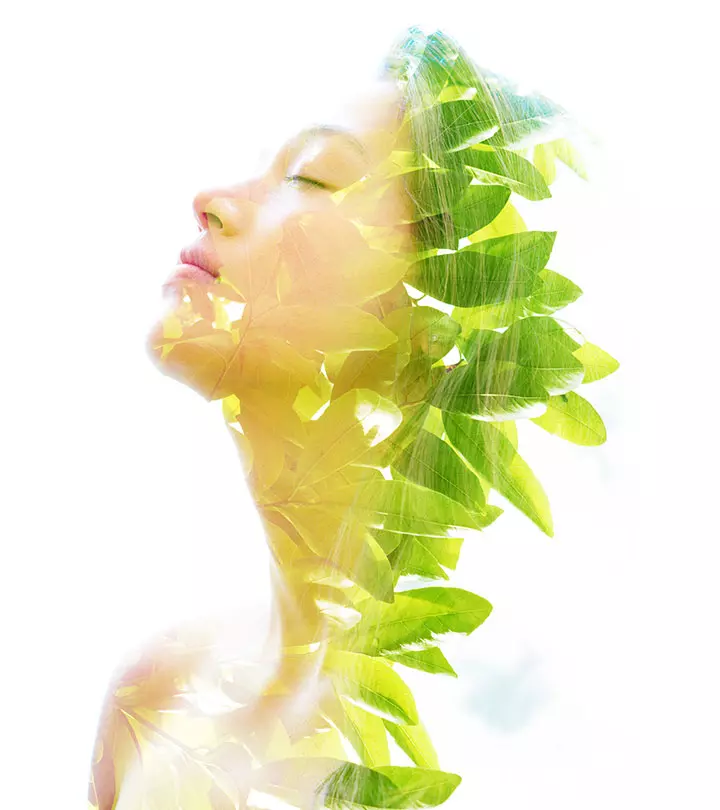




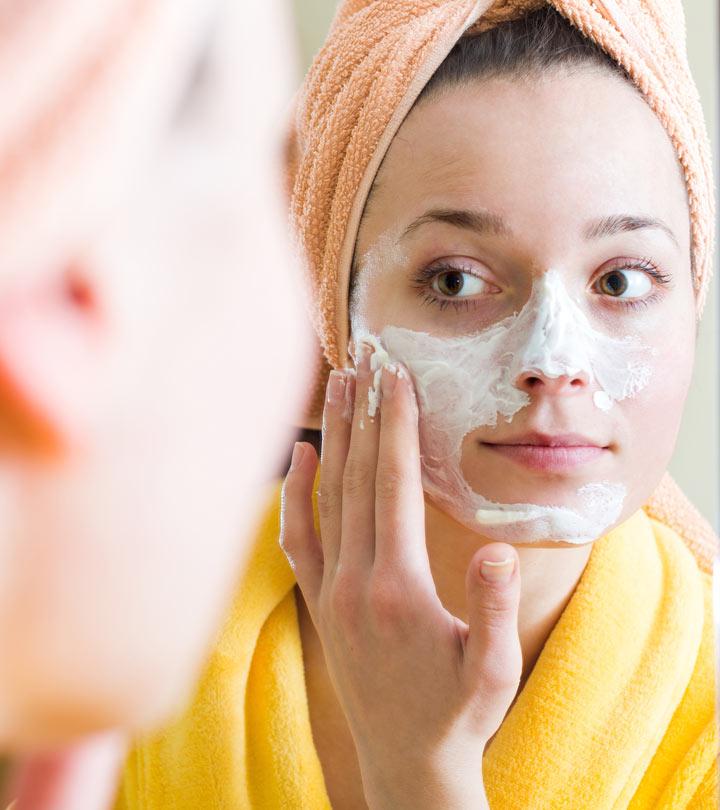




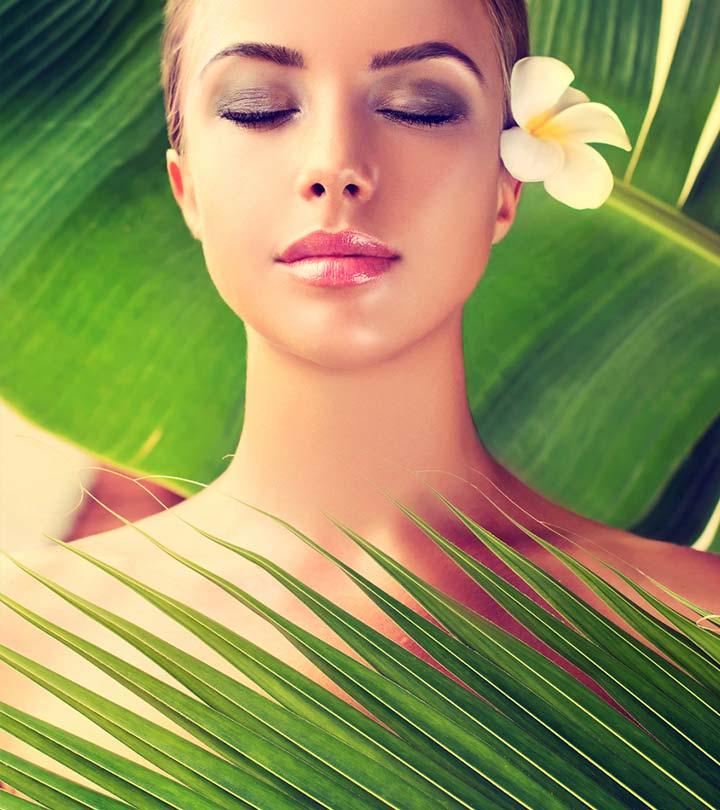



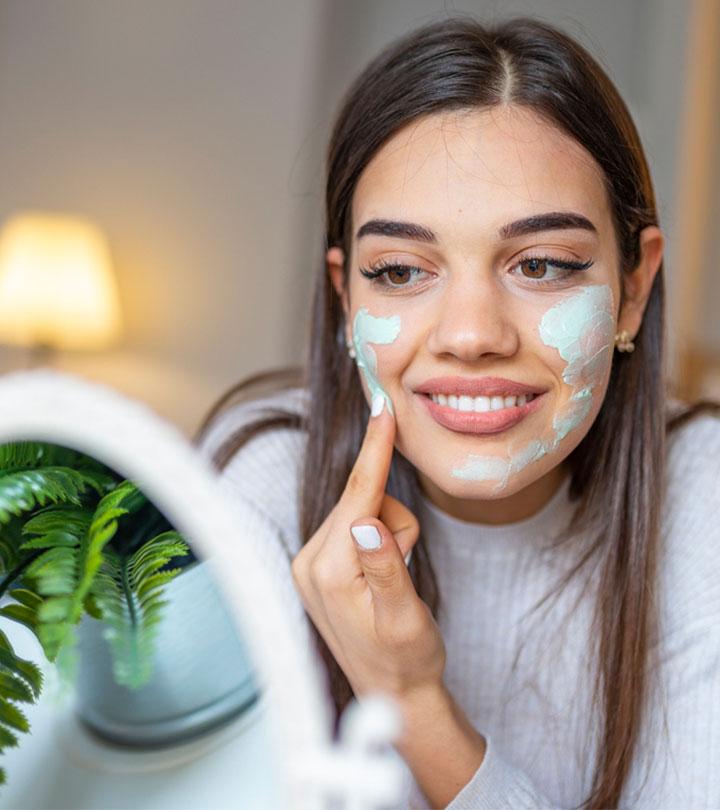
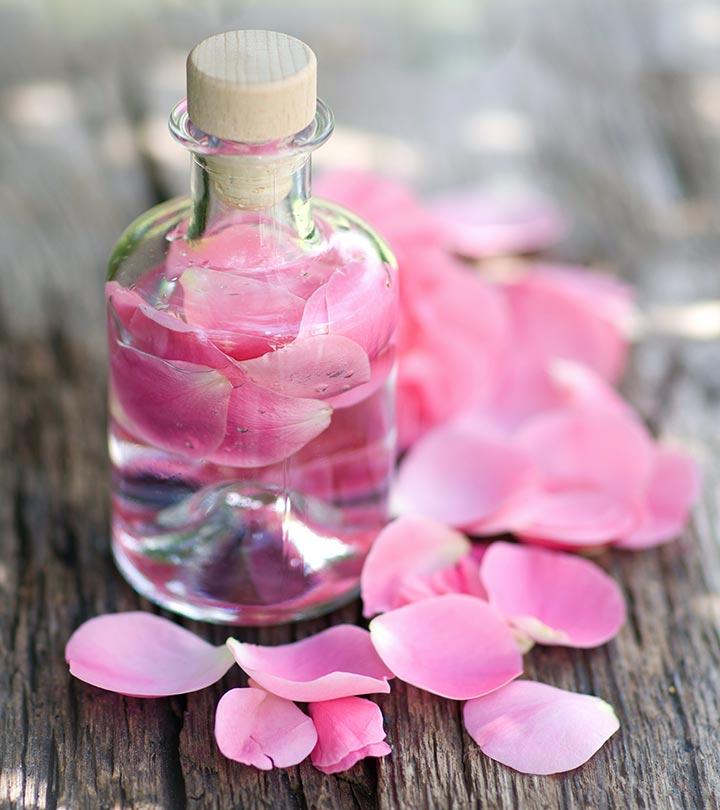
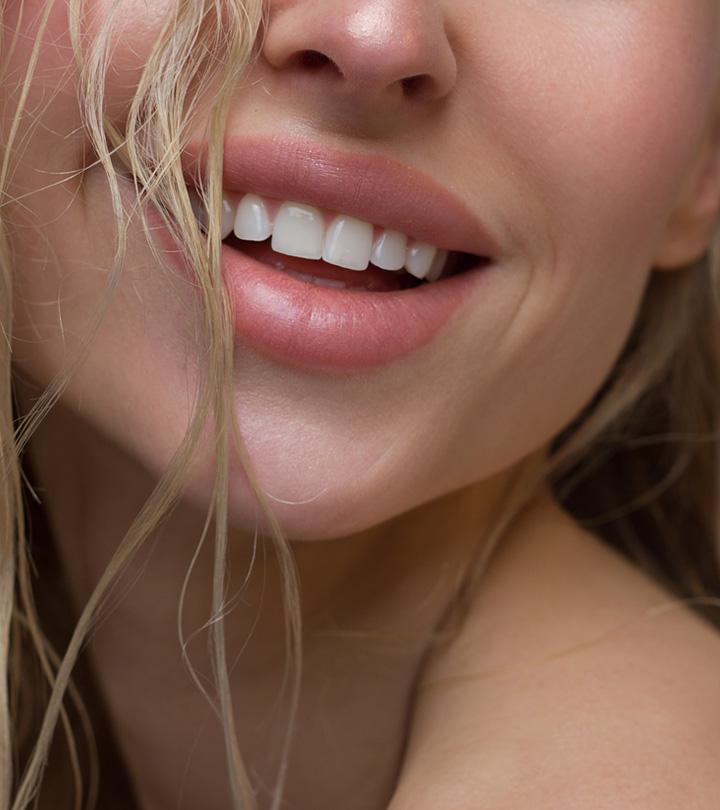
Community Experiences
Join the conversation and become a part of our empowering community! Share your stories, experiences, and insights to connect with other beauty, lifestyle, and health enthusiasts.